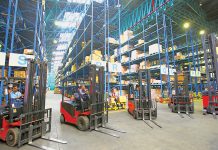TVS Industrial Logistics & Parks offers end-to-end industrial and warehousing logistics business solutions with stress on providing Grade A warehousing facilities in tier I, II, and III cities. The firm operates across 11 cities, including Hosur, Madurai, Chennai, and Vijayawada, says Manikandan Ramachandran, COO.
Ritika Arora Bhola
Tell us about the recent innovations and developments done by your company in the past few years?
We are focusing on leveraging innovative technology, latest construction heavy machinery and advanced water and power infrastructure to ensure timely project delivery and operational efficiency. Additionally, we offer tailor-made supply chain solutions to our clients, provide end-to-end solutions after understanding their requirements. Our expertise in engineering, procurement, and construction enables us to offer solutions for setting up new custom turnkey facilities. We are committed to sustainable practices and have obtained Excellence in Design for Greater Efficiencies certification for our warehouses. They are designed and constructed using green building practices, incorporating energy-efficient lighting, water management systems, and waste reduction measures, and minimizing harmful impact on the environment.
How would you rate infra for multimodal cargo movement in tier II and III cities? Will it be enough to fill demand-supply gap?
India’s infrastructure for multimodal cargo movement in tier II and III cities has shown progress, but the demand-supply gap can be improved. The increase in internet penetration, and the rise in demand for FMCGs, automobiles, and e-commerce in these cities presented significant growth opportunities for our businesses. Investments in infrastructure development, regulatory reforms and PPPs have the potential to improve the multimodal cargo movement infrastructure in tier II and III cities. We have expanded our footprint in Madurai, Cuttack, and Visakhapatnam, among others, contributing to the seamless cargo movement in India. We aim to offer last-mile connectivity to our customers helping them expand their reach across India through our hyper-localized network.
The warehousing sector is moving towards Grade A and tech-enabled warehouses. How much has been invested in the automated smart facilities?
Investments in Grade A facilities are being driven by increasing demand for organized warehousing space, changing consumer preferences, growth of e-commerce and online retail, advancements in tech, and evolving supply chain dynamics. These facilities are designed to offer improved storage capacity, operational efficiency, and cost savings, making them attractive to investors, developers, and occupiers in the sector. Our focus at TVS ILP is to provide a built-to-suit warehouse to our customers and we have invested in modern warehousing infra with specifications that cater to the needs of our customers. In the past, we have assisted our clients to execute customized floor designs and help as a technical partner to ensure a smooth start to their operations.
How are you planning to expand your network across India?
We are currently focusing on BTS facilities, where our customers come first. We prioritize the highest level of customization, offering complete office interiors, cranes, landscaping, amenities, and power solutions to meet our customers’ requirements. Our ongoing projects are spread across cities such as Coimbatore, Madurai, Chennai, Vijayawada, Cuttack, Kolkata, Siliguri, and Guwahati, with plans to expand our network up to 30 cities. Our plans are aimed at broadening our presence across India, beyond just metropolitan cities, or tier II and III cities. We have set a target of achieving a 20 million square feet platform in different cities within a couple of years.
Throw light on areas of concerns/challenges in the warehousing sector when it comes to the storage, handling, and distribution, especially in tier II and III cities?
There are a lot of regulatory compliances with respect to buying and leasing land for construction of a warehouse. The slow adoption of Grade Warehouses with advanced features such as automated systems, proper material handling equipment, and tech-driven processes can pose challenges in optimizing storage, handling, and distribution operations.
Getting building approvals and land conversion are challenging as the tier II and III cities witness extended time for the approval process. These cities are used to grade B and C warehouses, which have come into city limits are close to them. Hence, we need to identify the new micro market based on the cities’ recent development wherein we need to be taken into consideration of various factors such as availability of transporters in the vicinity, manpower, master planning, zoning of the land, among others. The new development shall be carried in the new micro market, which has to be identified.
Do you think the govt’s initiatives such as NLP and Gati Shakti among others would provide a much-needed boost to the logistics and warehousing sector?
Indeed, these government initiatives are expected to bring about positive changes in the industry, create new opportunities, and improve the overall operating environment. The aim of the NLP is to enhance logistics operations, boost multimodal connectivity, reduce logistics expenses, and improve efficiency of the supply chain ecosystem. PMGS focuses on developing critical transportation infra projects for ports, railways, roads, and steel sectors, which is likely to strengthen the multimodal connectivity in India.
The budget allocation for infrastructure projects, including the Indian Railways, and provisions such as coastal shipping with Viability Gap Funding for freight movement are likely to facilitate seamless cargo movement, reduce dependence on road transportation, and improve last-mile connectivity. The focus on digitization, automation, and development of smart warehousing is likely to enhance the efficiency of logistics operations.
How crucial is technology to enhance operational efficiency and reduce costs?
By adopting advanced technologies such as Artificial Intelligence, Machine Learning, IoT, Robotics, and automation, TVS ILP aims to optimize processes, reduce manual intervention, minimize errors, improve visibility, and enhance overall operational efficiency.
These technologies have the potential to streamline operations, reduce costs, and improve customer satisfaction, which are critical factors in the logistics and warehousing sector. We aim to embrace digitalization and automation in our operations to achieve improvements in productivity, accuracy, and cost-effectiveness.














